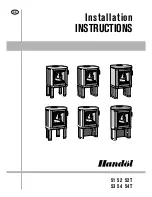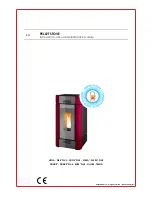
WESTFIRE · WF
15
· WF
16
· WF
20
12
WESTFIRE · WF
15
· WF
16
· WF
20
13
Overnight burning
Westfire stoves are wood stoves, wood burns more efficiently and cleanly if is burnt hotter. Westfire do not recom-
mend that their stoves are burnt overnight for this reason.
As a night time regime we recommend that the fire is loaded when hot and burnt for five minutes with the
secondary air valve fully open until the new wood has taken and is burning, then close the secondary air valve to
its operational position.
On returning to the stove in the morning the fire will have burn out, reload with some paper or firelighter and
some kindling and open all the values fully open and the stove will relight quickly. Beware as the ash bed will
have hot embers.
Use of operating tools
Always use the operating tools provided when handling parts likely to be hot when the stove is in use.
Maintenance
UNIQ 15,16, & 20 wood stove needs to have the ash removed from the stove at regular intervals. Make sure the
stove is completely cold before cleaning out ash (embers can remain hot for over 24 hours).
To clean the outside of the stove use a dry cloth.
Annual service
The inside of the stove should be serviced /cleaned once a year. To clean the inside, remove all ash, soot and tar
residue from the combustion chamber. Remove insulated chamber panels and baffle, dirt and soot will collect
behind it and this must be cleaned out. Check the quality of all insulated panels and replace any which are dam-
aged or cracked, replace stove door rope cord in the door. Check glass is correctly positioned.
The stove, the flue pipe connection and the chimney should be checked regularly by a qualified engineer. The
chimney should also be checked for blockages before relighting the stove if it has not been used for an extended
period of time.
The paint/ lacquer can wear thin in exposed places due to overheating. This, and other lacquer damage, may be
repaired using a Westfire Senotherm paint/lacquer spray available from your Westfire dealer.
Ash must be stored in a non-combustible container and must not be mixed with other combustible waste.
TROUBLE SHOOTING
1. Fire Will Not Burn
a) the air inlet is not obstructed in any way,
b) that chimneys and flueways are clear,
c) that a suitable fuel is being used,
d) that there is an adequate air supply into the room,
e) that an extractor fan is not fitted in the same room as the fire.
2. Fire Blazing Out Of Control
a) the doors are tightly closed,
b) the air control is turned down to the minimum setting,
c) the air inlet damper is closed and that it is not prevented from closing completely by a piece of ash,
d) a suitable fuel is being used,
e) the door seals are in good condition.
f) the chimney draft may be too strong
g) check ash pan seal and
h) check for ash below ash pan causing pan to not seat correctly and clean out.
3. Soot forms on the window
a) The firewood may be too wet
b) the intake of secondary air may be insufficient
c) fire not hot enough
4. The stove fails to heat fully
a) The firewood may be too wet
b) the intake of secondary air may be insufficient
5. Smoke or odour
a) Weak chimney draft
b) check for blockages in the flue pipe/chimney
c) check the height of the chimney in relation to the surroundings
6. Soot in the chimney
a) The firewood may be too wet
b) intake of secondary air may be insufficient
Chimney Fires
If the chimney is thoroughly and regularly swept, chimney fires should not occur. However, if a chimney fire does
occur turn the air control setting to the minimum, and tightly close the doors of the stove. This should cause the
chimney fire to go out in which case the control should be kept at the minimum setting until the fire in the stove
has gone out. The chimney and flueways should then be cleaned. If the chimney fire does not go out when the
above action is taken then the fire brigade should be called immediately.
After a chimney fire the chimney should be carefully examined for any damage. Expert advice should be sought
if necessary.
Permanent air vent
The stove requires a permanent and adequate air supply in order for it to operate safely and efficiently.
In accordance with current Building Regulations the installer may have fitted a permanent air supply vent into the
room in which the stove is installed to provide combustion air. This air vent should not under any circumstances
be shut off or sealed.
WARNING NOTE
Properly installed, operated and maintained this stove will not emit fumes into the dwelling. Occasional fumes
from de ashing and re fuelling may occur. However, persistent fume emission is potentially dangerous and must
not be tolerated. If fume emission does persist, then the following immediate action should be taken:
(a) Open doors and windows to ventilate room
(b) Let the fire out or eject and safely dispose of fuel from the appliance
(c) Check for flue or chimney blockage and clean if required
(d) Do not attempt to relight the fire until the cause of the fume emission has been identified and corrected.
If necessary seek expert advice.
The most common cause of fume emission is flueway or chimney blockage. For your own safety these must be
kept clean at all times.
IMPORTANT NOTES
General
Before lighting the stove check with the installer that the installation work and commissioning checks described
in the installation instructions have been carried out correctly and that the chimney has been swept clean, is
sound and free from any obstructions. As part of the stoves’ commissioning and handover the installer should
have shown you how to operate the stove correctly.
Use of fireguard
When using the stove in situations where children, aged and/or infirm persons are present a fireguard must be used
to prevent accidental contact with the stove. The fireguard should be manufactured in accordance with BS 6539.
Chimney cleaning
The chimney should be swept at least once a year for smokeless fuels and a minimum of twice a year for wood
and other fuels. It is important that the flue connection and chimney are swept prior to lighting up after a pro-
longed shutdown period.
If the stove is fitted in place of an open fire then the chimney should be swept one month after installation to clear
any soot falls which may have occurred due to the difference in combustion between the stove and the open fire.
In situations where it is not possible to sweep through the stove the installer will have provided alternative
UK
UK































